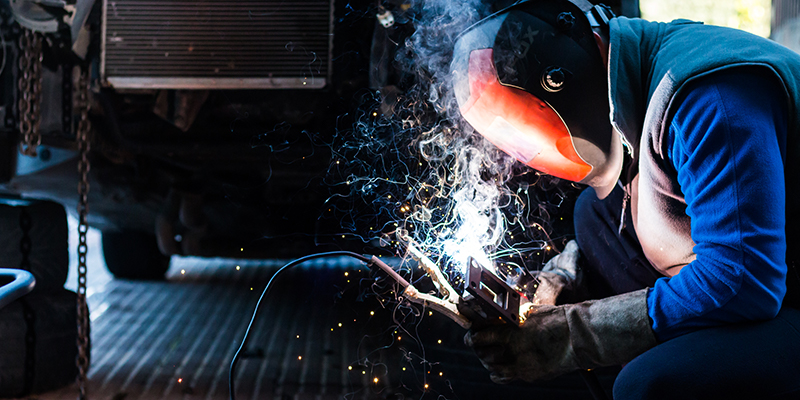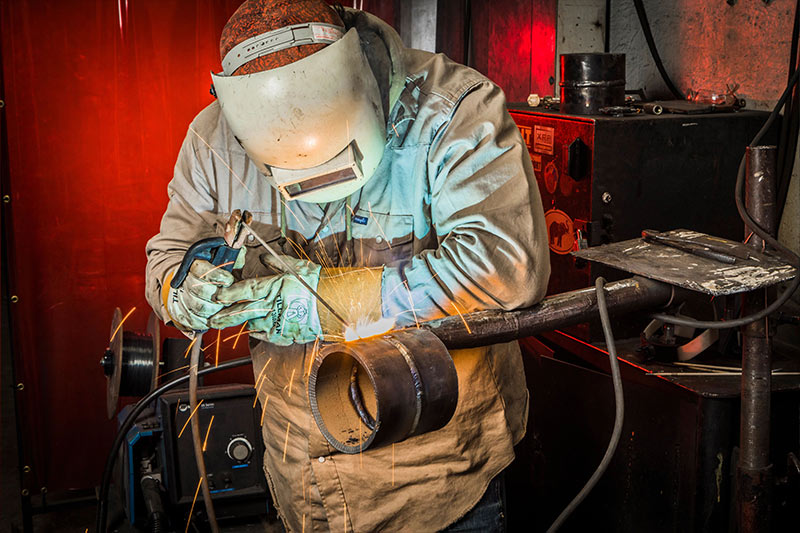Everything about Welding: Key Insights Into Techniques and Finest Practices for Success
Welding encompasses a variety of strategies, each suited for particular materials and applications. Understanding these methods, such as GMAW, SMAW, and TIG, is vital for accomplishing suitable outcomes. Furthermore, the best devices and safety and security methods can not be forgotten. As preparation and fixing play important duties in the welding procedure, grasping these components can significantly boost the high quality of the last product. What are the vital factors that assure a successful weld?
Understanding Various Welding Methods
Welding techniques encompass a range of techniques, each matched to details applications and materials. Amongst one of the most common strategies are Gas Metal Arc Welding (GMAW), Secured Steel Arc Welding (SMAW), and Tungsten Inert Gas Welding (TIG) GMAW, also referred to as MIG welding, is prominent for its speed and flexibility, making it ideal for slim products. SMAW, or stick welding, is favored for its simpleness and efficiency in outdoor environments, specifically with thicker metals. TIG welding provides accuracy and control, making it appropriate for intricate work and non-ferrous metals (Belgrade). Each technique has its special advantages and considerations, permitting welders to select the best approach based on the project's needs, product kind, and desired results. Understanding these methods is important for successful welding
Crucial Welding Equipment and Tools
While different welding strategies require particular abilities, the appropriate equipment and tools are similarly important for attaining top quality outcomes. Essential welding devices consists of welding equipments, which differ depending on the technique-- such as MIG, TIG, or stick welding. Protective gear, including aprons, headgears, and handwear covers, assurances security and comfort during the procedure. On top of that, clamps and fixtures aid secure products in position, guaranteeing accuracy in welds. Consumables like welding rods, wire, and securing gas are additionally critical components that affect the top quality of the weld. Tools such as mills and cutters promote surface area preparation and post-weld ending up, adding to a professional end result. Buying top notch devices ultimately boosts the efficiency and efficiency of welding jobs.
Security Practices in Welding
Proper security techniques are vital in the welding sector to protect workers from possible dangers. Welders need to use proper individual protective equipment (PPE), consisting of helmets with correct shading, handwear covers, and flame-resistant clothing. Adequate ventilation is essential to minimize exposure to harmful fumes and gases created throughout the welding procedure. Furthermore, employees should be learnt the proper handling of welding devices to stop crashes. Fire precaution, such as maintaining combustible materials far from the welding area and having fire extinguishers readily available, are required. Routine examinations of equipment and offices can help determine prospective dangers prior to they cause mishaps. By sticking to these safety and security methods, welders can produce a much safer working setting and minimize dangers related to their profession.
Readying Products for Welding
Preparing products for welding is an important action that considerably affects the high quality and integrity of the final item (Montana Mobile Welding and Repair Belgrade Fabrication). Appropriate prep work involves cleaning up the surfaces to remove impurities such as rust, dirt, and oil, which can jeopardize the weld. Techniques such as grinding, fining sand, or making use of solvents are commonly used to accomplish a clean surface area. Furthermore, guaranteeing that the materials fit with each other well is essential; gaps can cause weak welds. It's likewise crucial to think about the alignment and positioning of the elements, as this will certainly affect the convenience of welding and the final outcome. Finally, choosing the suitable filler material and ensuring compatibility with the base steels is important for achieving solid, durable welds
Tips for Getting High-Quality Welds
Achieving high-grade welds requires interest to information and adherence to finest practices throughout the welding process. Correct joint preparation is vital, making certain surfaces are clean and free from impurities. Selecting the proper filler product and welding strategy based on the base steels is vital for suitable bonding. Keeping consistent travel speed and angle while welding can protect against issues and promote harmony. Furthermore, regulating warm input is crucial; extreme heat can lead to bending and weakened joints. Frequently examining the welds throughout the welding services procedure permits immediate adjustments if essential. Ultimately, utilizing appropriate post-weld treatments, such as cleansing and stress and anxiety alleviation, can improve the durability and integrity of the weld, eventually making certain an effective outcome.
Fixing Common Welding Issues
Welding typically offers difficulties that can impact the top quality and integrity of the end product. Typical concerns such as porosity, irregular weld grains, and getting too hot can develop, each calling for specific repairing techniques. Comprehending these issues is vital for welders to boost their abilities and achieve perfect outcomes.
Porosity Issues Described
Porosity can often be forgotten, it remains an important problem in welding that can compromise the stability of a completed item. Porosity describes the visibility of tiny gas pockets within the weld bead, which can damage the joint and lead to early failing. This issue generally arises from impurities, dampness, or inappropriate securing gas protection throughout the welding procedure. To minimize porosity, welders should validate that the base materials are clean and dry, use appropriate securing gases, and preserve regular welding parameters. On a regular basis inspecting the devices and atmosphere can additionally assist identify prospective issues before they show up in the weld. Dealing with porosity properly is important for accomplishing strong, sturdy welds that fulfill quality standards.

Inconsistent Weld Beads
Inconsistent weld beads can considerably impact the top quality and stamina of a finished product. Different variables add to this issue, including improper travel rate, incorrect amperage settings, and irregular electrode angles. When the welder moves too quickly, a bead might appear slim and lack infiltration, while moving as well slowly can cause extreme build-up. In addition, using the wrong amperage can lead to either damaging or excessive spatter, both of which compromise weld integrity. The welder's method, such as inconsistent torch activity, can additionally lead to uneven bead appearance. To reduce these troubles, welders must concentrate on maintaining consistent, controlled activities and ensuring appropriate tools settings to attain harmony in their welds. Consistency is crucial to achieving reputable and strong welds.
Overheating and Warping Issues
Too much heat during the welding process can result in significant overheating and warping concerns, impacting the structural integrity of the work surface. These troubles often materialize as distortion, which can compromise placement and fit-up, making additional setting up testing. Factors adding to overheating consist of the choice of welding criteria, such as voltage and travel speed, as well as the kind of material being welded. To minimize these issues, welders should keep consistent traveling rate and appropriate warmth input while checking the workpiece temperature level. In addition, pre-heating or post-weld heat treatment can aid minimize stress and anxieties brought on by rapid cooling - Belgrade. Routine inspection and adherence to best practices are crucial in protecting against overheating and ensuring the durability and integrity of bonded structures
Regularly Asked Concerns
What Are the Job Opportunities in the Welding Industry?
The welding market provides varied career possibilities, including placements as welders, assessors, instructors, and engineers. Specialists can operate in manufacturing, building, aerospace, and automobile industries, benefiting from solid demand and competitive incomes in numerous functions.
How Can I Enhance My Welding Speed Without Sacrificing Top Quality?
To improve welding speed without sacrificing high quality, one ought to practice reliable methods, keep tools, maximize setups, and improve hand-eye coordination. Regular training and seeking comments can likewise significantly add to achieving faster, high-quality welds.
What Qualifications Are Available for Welders?
Various qualifications exist for welders, consisting of those from the American Welding Society (AWS), the National Facility for Building And Construction Education And Learning and Study look at these guys (NCCER), and numerous industry-specific organizations. These qualifications improve employability and show skill effectiveness.
Just How Does Welding Affect the Properties of Metals?
Welding influences the residential or commercial properties of metals by modifying their microstructure, which can cause changes read the article in hardness, ductility, and toughness. Warm input and cooling rates throughout the procedure significantly impact these material attributes.
Can I Bonded Dissimilar Metals Together?
